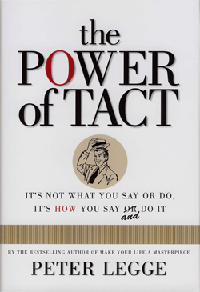Book review: The Power of Tact
By Peter Legge

Burnaby: Eaglet Publishing, Peter Legge Management Co. Ltd., 2008. ISBN 978-0-9781459-2-7. Paperback, 272 pages. $29.95. To order, e-mail dclarke@canadawide.com or go to www.peterlegge.com.
Authors and publishers often send books to the BCMJ Editorial Board for review. Depending on each member’s interest, a volunteer comes forward or someone is conscripted to write an insightful piece to be included in an upcoming issue. It is often very clear who should review the new book as it is in their area of expertise.
For example, JAW was a perfect fit to read a book about medical contributions made by physicians over the age of 65.
Usually these books have a medical connection, but not always. At our June meeting a nonmedical book arrived for consideration. Immediately after the title was read I looked up to meet the gaze of all of the Board members and editorial staff. Not a single one was looking anywhere else. The book? The Power of Tact.
“Why are you all looking at me? Oh so you jerks think I need to review a book on tact, do you? Well you’re all ugly, so there!” was my smooth reply.
The Power of Tact is a short and easy read. The 10 chapters deal with diplomacy, persuasion, communication, conflict resolution, negotiation, apologies, and more. The author uses examples and insights from his own business career to show how tact can be a powerful tool in our day-to-day interactions with others, whether at work, home, socializing, or while traveling.
His examples of how to use tact really shouldn’t surprise anyone, but I found them useful reminders of many of the things my mother taught me. As I read, I found myself reflecting on ways I could be more tactful on a daily basis. For this reason alone I believe this book is a worthwhile read. So in closing, I would like to thank the Editorial Board and staff for making me do this frickin’ review!
—DRR
